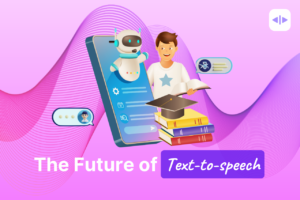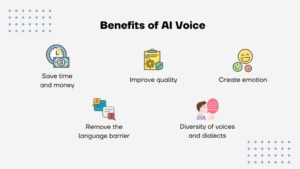Introduction:
In the fast-paced digital world we inhabit, the ability to efficiently process and disseminate information is paramount. Text-to-voice (TTV) technology, which converts written text into spoken words, has emerged as a transformative tool, significantly enhancing how we interact with content. From accessibility improvements to novel applications in various industries, free text-to-voice tools are reshaping communication in profound ways. This blog delves into the intricacies of TTV technology, its benefits, applications, and future potential.
Understanding Text-to-Voice Technology:
Text-to-voice, also known as text-to-speech (TTS), is a form of speech synthesis that transforms written text into spoken language. This technology relies on advanced algorithms and linguistic databases to generate natural-sounding speech. The process involves several steps:

Text Analysis: The system analyzes the input text, breaking it down into individual words and phrases.
Linguistic Processing: The text is processed to understand syntax, semantics, and prosody (intonation, stress, and rhythm).
Phonetic Conversion: The processed text is converted into phonetic transcriptions, mapping out how each word should sound.
Speech Synthesis: Using these phonetic transcriptions, the system generates spoken words through synthetic voices.
Modern TTS systems employ deep learning techniques and large datasets to produce more natural and human-like voices. These systems can adjust tone, pitch, speed, and emotion to create a more engaging auditory experience.
Benefits of Free Text-to-Voice Technology:
The availability of free TTV tools democratizes access to this powerful technology, offering numerous benefits across different domains:

- Accessibility and Inclusivity:
One of the most significant advantages of TTV technology is its ability to enhance accessibility. For individuals with visual impairments, reading difficulties, or learning disabilities such as dyslexia, TTS provides a vital means of accessing written content. By converting text into speech, TTV tools enable these individuals to consume information more easily and independently.
- Multitasking and Convenience:
In our busy lives, multitasking has become the norm. TTV technology allows users to listen to written content while engaging in other activities, such as commuting, exercising, or doing household chores. This convenience makes it easier for people to stay informed and entertained without being tethered to a screen.
- Language Learning and Pronunciation:
Language learners can greatly benefit from TTV technology. By hearing the correct pronunciation of words and sentences, learners can improve their speaking and listening skills. Additionally, TTS tools often support multiple languages, providing a valuable resource for those looking to acquire new language proficiencies.
- Enhanced Content Engagement:
For content creators, TTV technology offers a new way to engage audiences. Articles, blog posts, and other written materials can be converted into audio format, catering to auditory learners and those who prefer listening over reading. This can expand the reach of content and increase user engagement.
- Assistive Technology in Education:
In educational settings, TTS can serve as an assistive technology, aiding students who struggle with reading. By providing an auditory alternative to written text, TTS can enhance comprehension and retention of information, supporting diverse learning styles.
Applications of Free Text-to-Voice Technology:
The versatility of TTV technology makes it applicable across a wide range of fields. Here are some key areas where free TTV tools are making a significant impact:

- Education:
In addition to aiding students with disabilities, TTS technology is revolutionizing the educational landscape by providing alternative methods of content delivery. Audiobooks, interactive learning platforms, and digital textbooks integrated with TTS capabilities offer flexible learning options, catering to different preferences and needs.
- Content Creation and Media:
Podcasts, audiobooks, and voice-over services are booming industries that benefit immensely from TTV technology. Content creators can use TTS tools to convert written scripts into audio formats, saving time and resources. This is particularly useful for indie creators and small businesses that may not have the budget for professional voice actors.
- Customer Service and Support:
Businesses are increasingly adopting TTS technology in their customer service operations. Interactive voice response (IVR) systems, chatbots, and virtual assistants utilize TTS to provide efficient and consistent customer interactions. This automation can improve response times and customer satisfaction while reducing operational costs.
4 Accessibility Services:
Beyond individual use, TTS technology is integral to broader accessibility services. Public information systems, such as announcements in transportation hubs and emergency alerts, leverage TTS to ensure information is disseminated to everyone, including those with visual impairments.
Future Potential of Text-to-Voice Technology:
As TTS technology continues to evolve, its future potential seems boundless. Several emerging trends and advancements promise to further enhance its capabilities:

- Improved Naturalness and Expressiveness:
Ongoing research in artificial intelligence and machine learning is focused on making synthetic voices more natural and expressive. By incorporating emotional nuances and human-like intonations, future TTS systems will provide even more engaging and relatable auditory experiences.
- Personalized Voices:
Customization is a growing trend in TTS technology. Users may soon have the ability to create personalized synthetic voices that reflect their unique vocal characteristics. This could be particularly valuable for individuals who lose their ability to speak due to medical conditions, allowing them to preserve their voice.
As AR and VR technologies advance, TTS is expected to play a crucial role in creating immersive experiences. In virtual environments, TTS can be used to narrate content, guide users, and provide real-time information, enhancing the overall user experience.

- Multilingual and Real-Time Translation:
The integration of real-time translation with TTS technology has the potential to break down language barriers. Imagine a world where you can listen to any written content in your preferred language, instantly translated and spoken with natural fluency.
- Expanded Use in IoT and Smart Devices:
The proliferation of Internet of Things (IoT) devices and smart home technology opens up new possibilities for TTS applications. Voice-enabled smart assistants, such as Amazon Alexa and Google Home, already utilize TTS to interact with users.
Conclusion:
Free text-to-voice technology is more than just a convenience; it is a transformative force in the way we communicate and interact with the world. By making written content accessible to all, facilitating multitasking, and enhancing learning, TTS technology is breaking down barriers and creating new opportunities for engagement. As we look to the future, the potential of TTS technology is vast and exciting. Advances in natural language processing, AI, and machine learning will continue to drive its evolution, making synthetic voices even more lifelike and versatile.

